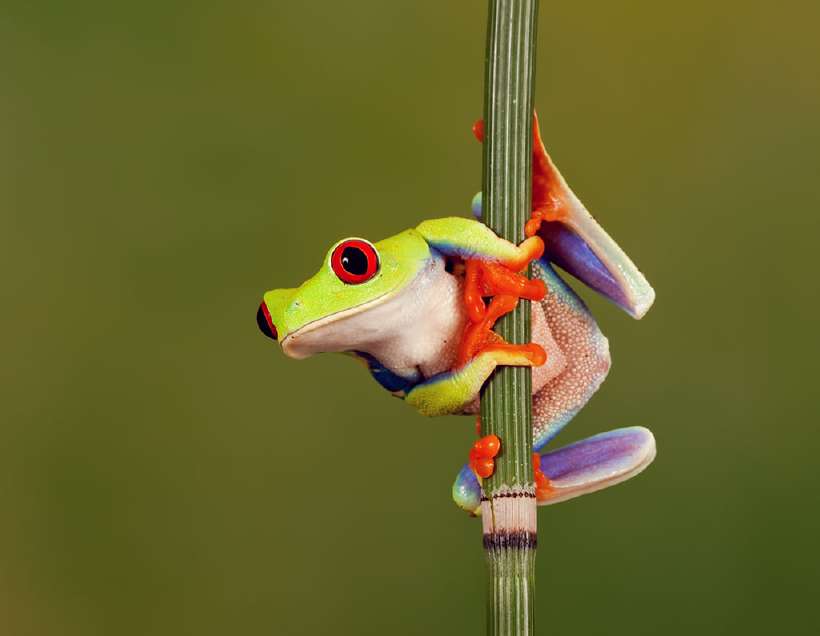How are Frogs Different From Toads?
Home / Science for Kids / 5Ws & H For Kids / How are Frogs Different From Toads?
If you travel back tens of millions of years to the age of dinosaurs, you may possibly hear a rhythmic musical croaking from marshy ponds or even under your feet. And if you look closely you would probably find the common frog goggling away at you.
Amazing isn’t it? Not many people know how ancient frogs are. Scientists have traced their ancestry to 200 million years and found that these animals haven’t changed in the least!
Frogs are amphibians. That is, they can live both in water and on land. This gives them an advantage over other animals. If there is food scarcity or predators on land, they can jump into the water and if they want to catch juicy flies they can hop back on to land.
Like other amphibians, frogs are cold-blooded and prefer to live in moist climates. This means that they can regulate their body temperatures with the surrounding temperature. If it becomes too cold, some frogs burrow underground or in the mud at the bottom of marshy ponds. They can survive in a frozen state for weeks and months.

But is there a difference between frogs and toads? Technically, toads are frogs and both are classified under the order Anura. Under this group, animals with a dry warty skin with short hind legs are called ‘toads’, while animals with a moist skin and long strong hind legs for swimming and jumping are called ‘frogs’.
However, scientists refer to this group as frogs as there is a very thin line separating the two. For instance, there are certain frogs with a warty skin while some toads have a slimy moist skin.
Both have adapted themselves admirably to their environment. They are found in all continents, from deserts to mountains to the coldest region in the Arctic. Everywhere except Antarctica. The Indian Common Toad has been found in the Himalayas at a height of 8,000 metres (26,000 feet) and the same species has also been spotted inside a coal mine at a depth of 340 m (1,100 ft).
On an average, a frog is more adapted to living on water. They have strong legs with webs between the toes to help them swim. Their two front legs have four toes each, while the hind legs have five toes each. Land dwelling and tree dwelling frogs have shorter hind legs to help them in walking or climbing. Tree frogs have large, round toe pads that have suction cups like lizards, to help them cling to branches or to wet and smooth surfaces.
Some frogs can fly. Well, not exactly fly, but glide. The Malayan flying frog and the Indian flying frog use their webbed feet as a parachute to glide from a treetop to the base of another tree.
Frogs are voracious eaters, eating anything they find from insects and shrews to worms and smaller fish. Some frogs are vegetarians like the Indian Green Frog that eats leaves or vegetable matter, while the Indian Bull Frog is reported to eat mice, birds, other frogs and even snakes!
Both frogs and toads try to blend into the surroundings they are found in. And become near invisible among the leaves and marshes unless you look very closely. However, some frogs of Central and South America do not want to camouflage themselves and instead are brilliantly coloured in yellow, orange and red. This colouring is a warning to their natural enemies to avoid eating them, as they are sometimes poisonous.
It is interesting to note that there are many non-poisonous frogs that try to bluff their way through with similar colouring. Since predators avoid attacking the poisonous frogs, these non-poisonous animals too escape.
Though these creatures look ugly and repulsive, frogs are very useful to mankind as they eat insects, particularly mosquitoes and flies, that we consider pests. However, their most important contribution is the secretion of certain chemical compounds from their skin.
Some chemicals were recently isolated from the skin of a South American frog which led to the discovery of a painkiller that is more powerful than morphine but less addictive.
695 words |
6 minutes
Readability:
Grade 8 (13-14 year old children)
Based on Flesch–Kincaid readability scores
Filed under: 5ws and h
Tags: #indians, #scientists, #america, #toads, #frogs, #predators
You may also be interested in these:
Why are Some Reptiles Brightly Coloured?
Finding a Match for an Elephant
The First Woman to Fly High in the Air Force
Chimp Traits
Artist of the Free Spirit